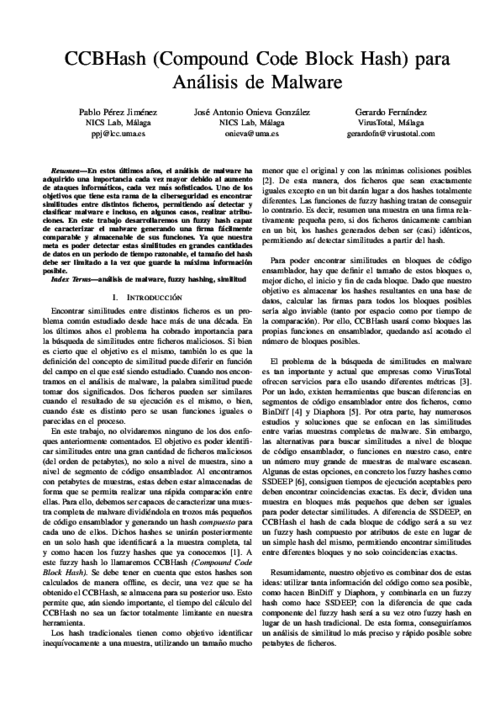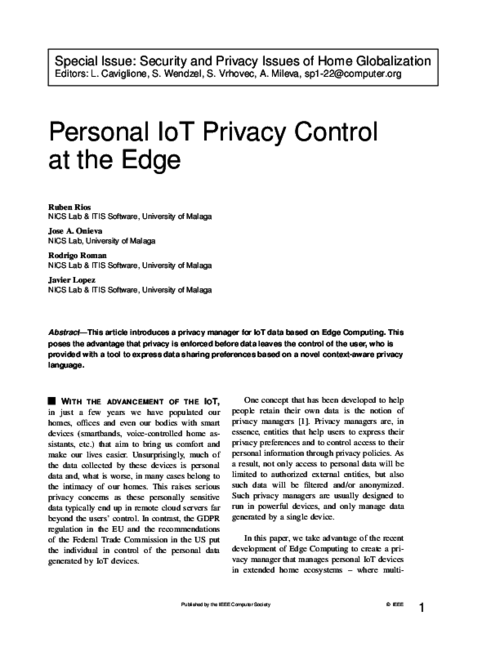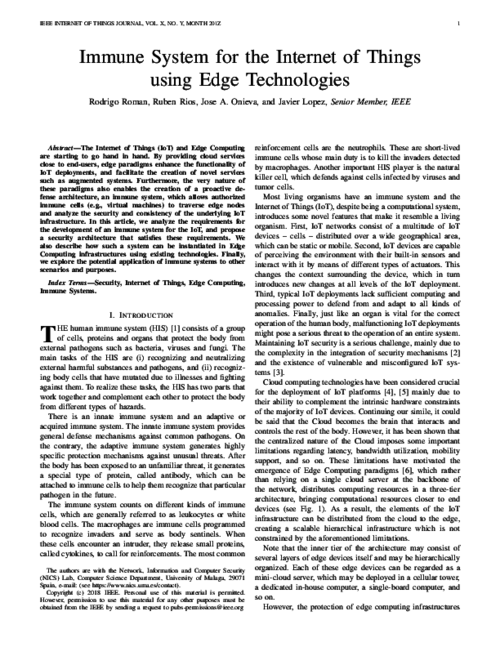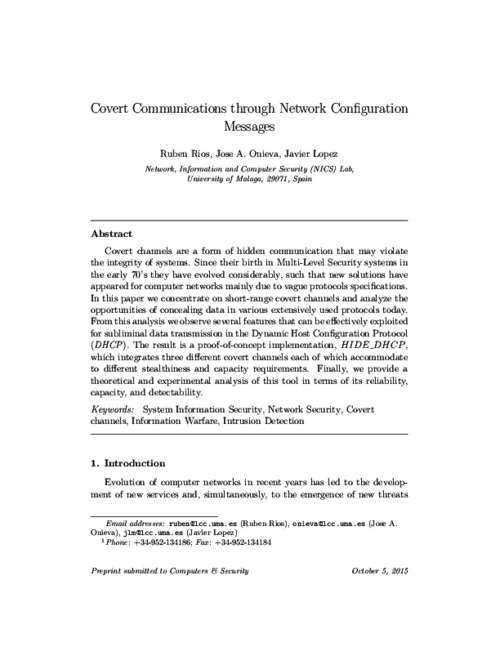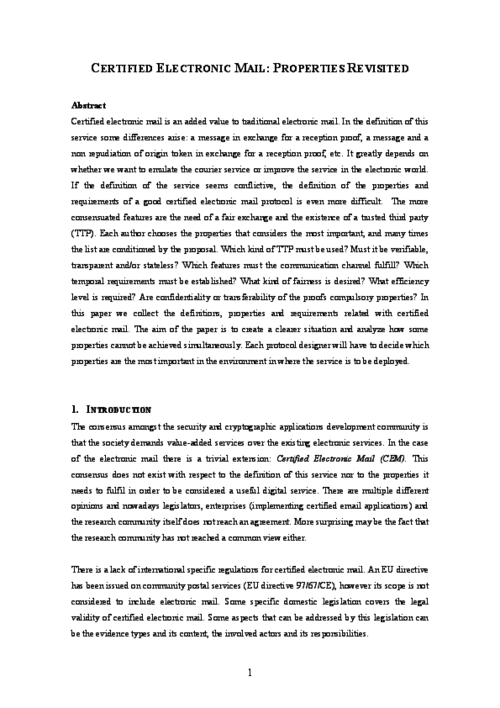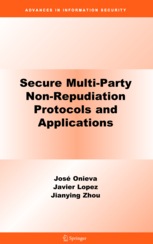José a. Onieva
Associate Professor
Computer Science Department, University of Malaga
Campus de Teatinos s/n,29071 – Malaga (Spain)
Phone: +34 952 132 898 | Fax: +34 952 131 397
E-mail: onieva@uma.es
Domain of interest and research
- Digital Identity
- Covert Channels
- Malware Analysis
- Non-repudiation protocols, Fair exchange protocols, Certified Electronic Protocols and Contract Signing Protocols
- Edge/Fog Computing Security
Orcid: https://orcid.org/0000-0002-7280-090X
Researcher ID: K-9846-2014
Current research
- Edge/Fog Computing: In NICS, we are trying to define the basic security services for Fog and Edge Computing because we think that this paradigm brings new challenges and opportunities that makes providing these services to the resource continiuum from cloud to sensors an exciting task. SMOG and SecureEDGE are allowing us to take the first steps towards that objective.
- Malware Analysis: We are tackling different problems related with Malware:
- Malware analysis is complicated due to anti-forensic techniques. This needs to be tackled by continuous new counter techniques.
- Indicators of Compromise need to be intelligently collected and graphed to allow Malware Investigations independently from Malware complexity and with auto expanding graphs.
- Binary Code similarity needs to be effective and efficiently processed in order to correlate similar behaviours among petabytes of malware code. One of our efforts to this objective is the design of a a new fuzzy hash function that is efficient and recognizes code functionality.
- IA results applied to malware
Education
I received the M.Sc. and Ph.D. degrees in computer science from the University of Málaga, Spain, in 2002, and 2006, respectively.
Relevant publications
Jose A. Onieva, Pablo Pérez Jiménez, Javier Lopez
Malware similarity and a new fuzzy hash: Compound Code Block Hash (CCBHash)
In: Computers & Security, vol. 142, 2024, ISBN: 0167-4048.
BibTeX | Links:
@article{Onieva0000,
title = {Malware similarity and a new fuzzy hash: Compound Code Block Hash (CCBHash)},
author = {Jose A. Onieva and Pablo P\'{e}rez Jim\'{e}nez and Javier Lopez},
doi = {10.1016/j.cose.2024.103856},
isbn = {0167-4048},
year = {2024},
date = {2024-04-21},
urldate = {2024-04-21},
journal = {Computers \& Security},
volume = {142},
keywords = {},
pubstate = {published},
tppubtype = {article}
}
Pablo Pérez Jiménez, Jose A. Onieva, Gerardo Fernandez
CCBHash (Compound Code Block Hash) para Análisis de Malware
In: XVII Reunión Española sobre Criptología y Seguridad de la Información, pp. 168-173, 2022, ISBN: 978-84-19024-14-5.
@inproceedings{2033,
title = {CCBHash (Compound Code Block Hash) para An\'{a}lisis de Malware},
author = {Pablo P\'{e}rez Jim\'{e}nez and Jose A. Onieva and Gerardo Fernandez},
url = {/wp-content/papers/2033.pdf},
isbn = {978-84-19024-14-5},
year = {2022},
date = {2022-11-01},
urldate = {2022-11-01},
booktitle = {XVII Reuni\'{o}n Espa\~{n}ola sobre Criptolog\'{i}a y Seguridad de la Informaci\'{o}n},
pages = {168-173},
abstract = {En estos \'{u}ltimos a\~{n}os, el an\'{a}lisis de malware ha adquirido una importancia cada vez mayor debido al aumento de ataques inform\'{a}ticos, cada vez m\'{a}s sofisticados. Uno de los objetivos que tiene esta rama de la ciberseguridad es encontrar similitudes entre distintos ficheros, permitiendo as\'{i} detectar y clasificar malware e incluso, en algunos casos, realizar atribuciones.
En este trabajo desarrollaremos un fuzzy hash capaz de caracterizar el malware generando una firma f\'{a}cilmente comparable y almacenable de sus funciones. Ya que nuestra meta es poder detectar estas similitudes en grandes cantidades de datos en un periodo de tiempo razonable, el tama\~{n}o del hash debe ser limitado a la vez que guarde la m´axima informaci\'{o}n posible.},
keywords = {},
pubstate = {published},
tppubtype = {inproceedings}
}
En este trabajo desarrollaremos un fuzzy hash capaz de caracterizar el malware generando una firma fácilmente comparable y almacenable de sus funciones. Ya que nuestra meta es poder detectar estas similitudes en grandes cantidades de datos en un periodo de tiempo razonable, el tamaño del hash debe ser limitado a la vez que guarde la m´axima información posible.
Ruben Rios, Jose A. Onieva, Rodrigo Roman, Javier Lopez
Personal IoT Privacy Control at the Edge
In: IEEE Security & Privacy, vol. 20, pp. 23 – 32, 2022, ISSN: 1540-7993.
@article{rios2022pmec,
title = {Personal IoT Privacy Control at the Edge},
author = {Ruben Rios and Jose A. Onieva and Rodrigo Roman and Javier Lopez},
url = {/wp-content/papers/rios2022pmec.pdf},
doi = {10.1109/MSEC.2021.3101865},
issn = {1540-7993},
year = {2022},
date = {2022-01-01},
urldate = {2022-01-01},
journal = {IEEE Security \& Privacy},
volume = {20},
pages = {23 - 32},
publisher = {IEEE},
abstract = {This article introduces a privacy manager for IoT data based on Edge Computing. This poses the advantage that privacy is enforced before data leaves the control of the user, who is provided with a tool to express data sharing preferences based on a novel context-aware privacy language.},
keywords = {},
pubstate = {published},
tppubtype = {article}
}
Jose A. Onieva, Ruben Rios, Rodrigo Roman, Javier Lopez
Edge-Assisted Vehicular Networks Security
In: IEEE Internet of Things Journal, vol. 6, pp. 8038-8045, 2019, ISSN: 2327-4662.
@article{onieva2019vec,
title = {Edge-Assisted Vehicular Networks Security},
author = {Jose A. Onieva and Ruben Rios and Rodrigo Roman and Javier Lopez},
url = {/wp-content/papers/onieva2019vec.pdf},
doi = {10.1109/JIOT.2019.2904323},
issn = {2327-4662},
year = {2019},
date = {2019-10-01},
urldate = {2019-10-01},
journal = {IEEE Internet of Things Journal},
volume = {6},
pages = {8038-8045},
publisher = {IEEE Computer Society},
abstract = {Edge Computing paradigms are expected to solve some major problems affecting current application scenarios that rely on Cloud computing resources to operate. These novel paradigms will bring computational resources closer to the users and by doing so they will not only reduce network latency and bandwidth utilization but will also introduce some attractive context-awareness features to these systems. In this paper we show how the enticing features introduced by Edge Computing paradigms can be exploited to improve security and privacy in the critical scenario of vehicular networks (VN), especially existing authentication and revocation issues. In particular, we analyze the security challenges in VN and describe three deployment models for vehicular edge computing, which refrain from using vehicular- to-vehicular communications. The result is that the burden imposed to vehicles is considerably reduced without sacrificing the security or functional features expected in vehicular scenarios.},
keywords = {},
pubstate = {published},
tppubtype = {article}
}
Rodrigo Roman, Ruben Rios, Jose A. Onieva, Javier Lopez
Immune System for the Internet of Things using Edge Technologies
In: IEEE Internet of Things Journal, vol. 6, pp. 4774-4781, 2019, ISSN: 2327-4662.
@article{roman2018VIS,
title = {Immune System for the Internet of Things using Edge Technologies},
author = {Rodrigo Roman and Ruben Rios and Jose A. Onieva and Javier Lopez},
url = {/wp-content/papers/roman2018VIS.pdf
https://ieeexplore.ieee.org/document/8449989/},
doi = {10.1109/JIOT.2018.2867613},
issn = {2327-4662},
year = {2019},
date = {2019-06-01},
urldate = {2019-06-01},
journal = {IEEE Internet of Things Journal},
volume = {6},
pages = {4774-4781},
publisher = {IEEE Computer Society},
abstract = {The Internet of Things (IoT) and Edge Computing are starting to go hand in hand. By providing cloud services close to end-users, edge paradigms enhance the functionality of IoT deployments, and facilitate the creation of novel services such as augmented systems. Furthermore, the very nature of these paradigms also enables the creation of a proactive defense architecture, an immune system, which allows authorized immune cells (e.g., virtual machines) to traverse edge nodes and analyze the security and consistency of the underlying IoT infrastructure. In this article, we analyze the requirements for the development of an immune system for the IoT, and propose a security architecture that satisfies these requirements. We also describe how such a system can be instantiated in Edge Computing infrastructures using existing technologies. Finally, we explore the potential application of immune systems to other scenarios and purposes.},
keywords = {},
pubstate = {published},
tppubtype = {article}
}
Ruben Rios, Jose A. Onieva, Javier Lopez
Covert Communications through Network Configuration Messages
In: Computers & Security, vol. 39, Part A, pp. 34 – 46, 2013, ISSN: 0167-4048.
@article{rios2013a,
title = {Covert Communications through Network Configuration Messages},
author = {Ruben Rios and Jose A. Onieva and Javier Lopez},
url = {/wp-content/papers/rios2013a.pdf},
doi = {10.1016/j.cose.2013.03.004},
issn = {0167-4048},
year = {2013},
date = {2013-11-01},
urldate = {2013-11-01},
journal = {Computers \& Security},
volume = {39, Part A},
pages = {34 - 46},
publisher = {Elsevier},
abstract = {Covert channels are a form of hidden communication that may violate the integrity of systems. Since their birth in Multi-Level Security systems in the early 70’s they have evolved considerably, such that new solutions have appeared for computer networks mainly due to vague protocols specifications. In this paper we concentrate on short-range covert channels and analyze the opportunities of concealing data in various extensively used protocols today. From this analysis we observe several features that can be effectively exploited for subliminal data transmission in the Dynamic Host Configuration Protocol (DHCP). The result is a proof-of-concept implementation, HIDE_DHCP, which integrates three different covert channels each of which accommodate to different stealthiness and capacity requirements. Finally, we provide a theoretical and experimental analysis of this tool in terms of its reliability, capacity, and detectability.},
keywords = {},
pubstate = {published},
tppubtype = {article}
}
Josep L. Ferrer-Gomila, Jose A. Onieva, Magdalena Payeras, Javier Lopez
Certified electronic mail: Properties revisited
In: Computers & Security, vol. 29, no. 2, pp. 167 – 179, 2010, ISSN: 0167-4048.
@article{FerrerGomilla2009,
title = {Certified electronic mail: Properties revisited},
author = {Josep L. Ferrer-Gomila and Jose A. Onieva and Magdalena Payeras and Javier Lopez},
url = {/wp-content/papers/FerrerGomilla2009.pdf
http://www.sciencedirect.com/science/article/B6V8G-4WR19XR-1/2/eda89f747b077fc68fa061f213ddf6d5},
doi = {10.1016/j.cose.2009.06.009},
issn = {0167-4048},
year = {2010},
date = {2010-01-01},
urldate = {2010-01-01},
journal = {Computers \& Security},
volume = {29},
number = {2},
pages = {167 - 179},
abstract = {Certified electronic mail is an added value to traditional electronic mail. In the definition of this service some differences arise: a message in exchange for a reception proof, a message and a non repudiation of origin token in exchange for a reception proof, etc. It greatly depends on whether we want to emulate the courier service or improve the service in the electronic world. If the definition of the service seems conflictive, the definition of the properties and requirements of a good certified electronic mail protocol is even more difficult. The more consensuated features are the need of a fair exchange and the existence of a trusted third party (TTP). Each author chooses the properties that considers the most important, and many times the list is conditioned by the proposal. Which kind of TTP must be used? Must it be verifiable, transparent and/or stateless? Which features must the communication channel fulfil? Which temporal requirements must be established? What kind of fairness is desired? What efficiency level is required? Are confidentiality or transferability of the proofs compulsory properties? In this paper we collect the definitions, properties and requirements related with certified electronic mail. The aim of the paper is to create a clearer situation and analyze how some properties cannot be achieved simultaneously. Each protocol designer will have to decide which properties are the most important in the environment in where the service is to be deployed.},
keywords = {},
pubstate = {published},
tppubtype = {article}
}
Jose A. Onieva, Javier Lopez, Jianying Zhou
Secure Multi-Party Non-Repudiation Protocols and Applications
Springer, 2009, ISBN: 978-0-387-75629-5.
BibTeX | Links:
@book{Onieva2009,
title = {Secure Multi-Party Non-Repudiation Protocols and Applications},
author = {Jose A. Onieva and Javier Lopez and Jianying Zhou},
url = {http://www.springer.com/computer/security+and+cryptology/book/978-0-387-75629-5},
doi = {10.1007/978-0-387-75630-1},
isbn = {978-0-387-75629-5},
year = {2009},
date = {2009-01-01},
urldate = {2009-01-01},
volume = {43},
publisher = {Springer},
organization = {Springer},
series = {Advances in Information Security},
keywords = {},
pubstate = {published},
tppubtype = {book}
}
Attended courses and seminars
- IPICS’05. International Summer School. University of the Aegean, Chios, Greece. 18-29 July, 2005.
Scientific Activities
- General (co)chair:
- II Workshop in Information Security Theory and Practices 2008 (WISTP 2008). Sevilla, May 13-16.
- 1st FTRA International Workshop on Convergence Security in Pervasive Environments (IWCS 2011), Crete, Greece, June 28-30, 2011.
- FTRA/IEEE 3rd International Conference on Computer Science and its Applications (CSA-11).
- Program committee member (a selection):
- 5th International Conference on Security and Cryptography (SECRYPT 2010). Athens, Greece, 26-28 July.
- IV Workshop in Information Security Theory and Practices 2010 (WISTP 2010), Passau, Germany, April 2010.
- Fifth International Conference on Availability, Reliability and Security (ARES 2010), Krakow, Poland 15-18 February.
- 6th International ICST Conference on Security and Privacy in Communication Networks (SecureComm 2010), Singapore, 7-10 Septiember.
- 4th International Conference on Network and System Security (NSS 2010). Melbourne, Australia, 1-3 September.
- 8th IEEE Consumer Communications and Networking Conference (CCNC 2011), Security Track. Las Vegas, USA, 8-11 January.
- V Workshop in Information Security Theory and Practices 2010 (WISTP 2011), Heraklion, Greece, 1-3 June.
- 8th International Conference on Availability, Reliability and Security (ARES 2013), University of Regensburg, Germany. 2-6, September, 2013.
- 8th International Conference on Security of Information and Networks (SIN2015). Sochi, Russia, 8-10 September, 2015.
- Fifth International Symposium on Security in Computing and Communications (SSCC’17), Karnataka, India, 13-16 September 2017.
- Fifth Workshop on Cryptography and Security in Computing Systems (CS2 2018). Manchester, UK, 24 January.
- 2019 European Workshop on Security and Privacy in Edge Computing (EuroSPEC 2019). Stockholm, Sweden, 16 June, 2019.




